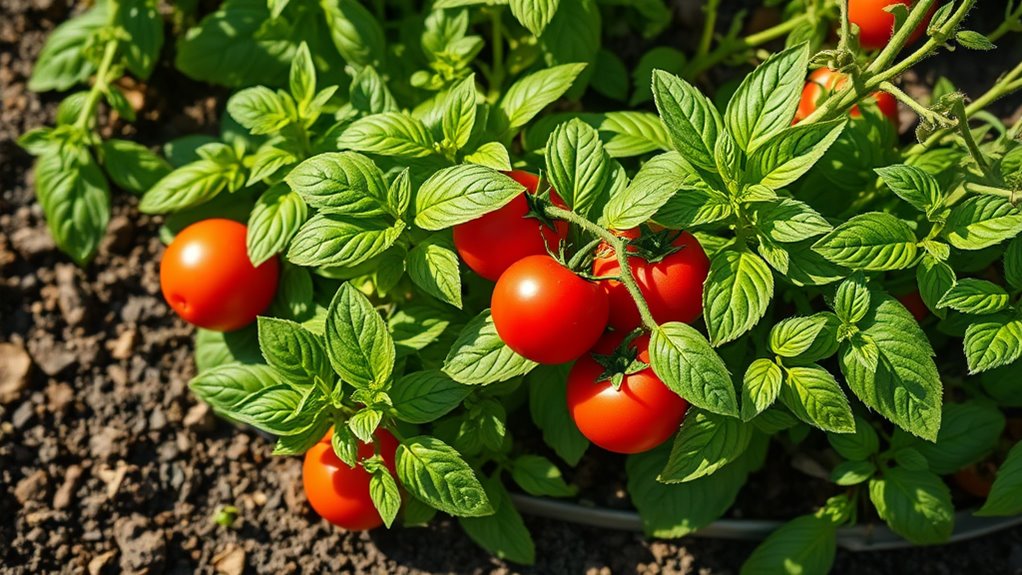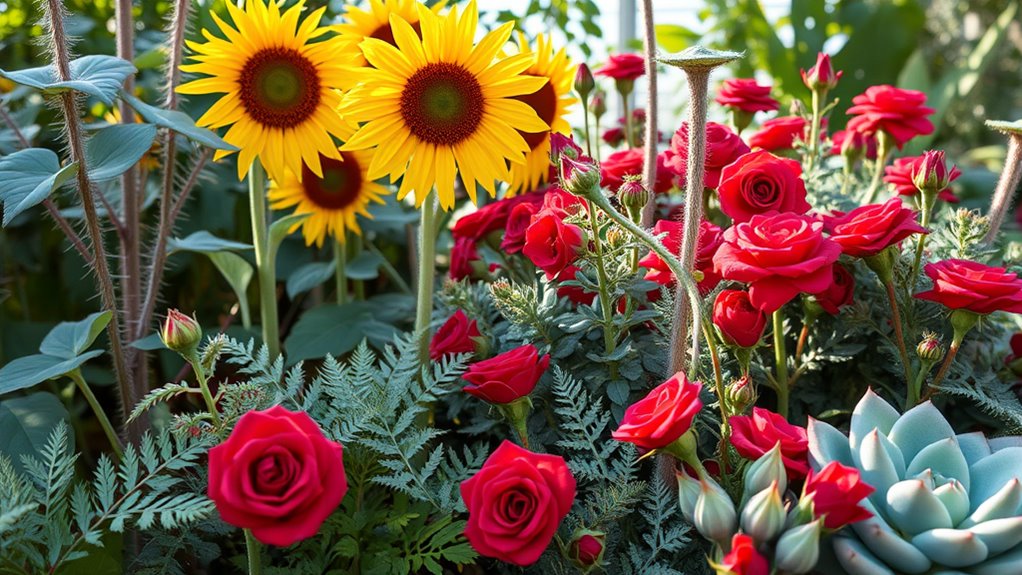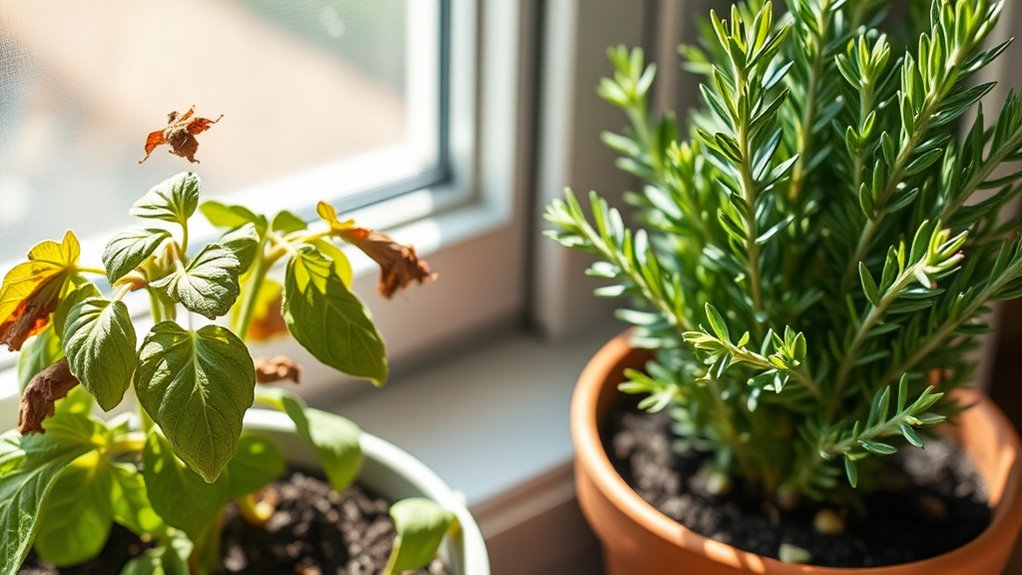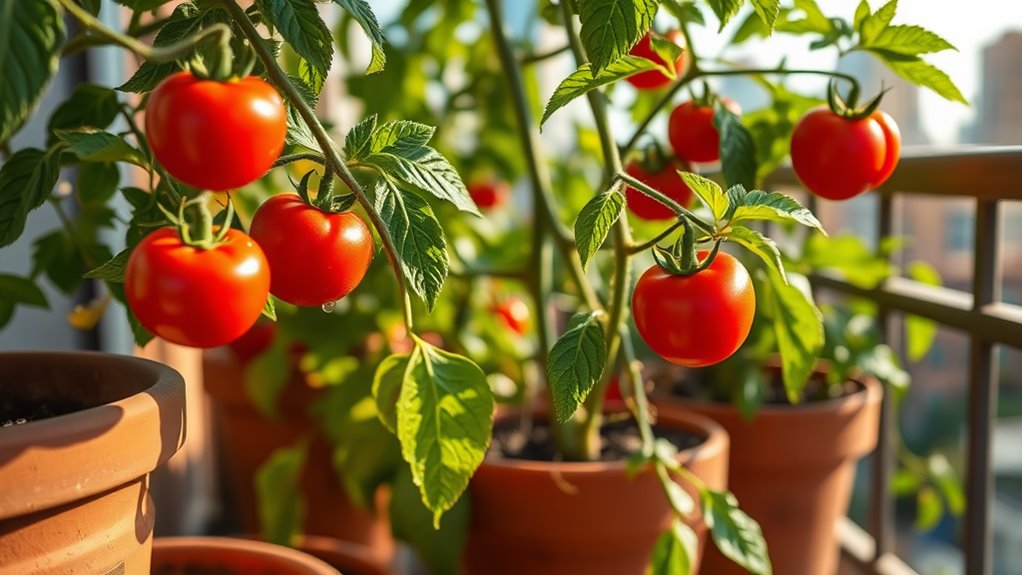These Plants Love to Be Together – The Science of Pairing
You’ll discover how science backs companion planting, where plants like beans and corn thrive together—beans fix nitrogen to fuel corn’s growth, while basil repels aphids from tomatoes. This strategy enhances soil nutrients, deters pests naturally, and boosts biodiversity in your garden. By pairing wisely, you’ll see healthier yields and a balanced ecosystem, with even more insights on classic combinations waiting to transform your green space.
Key Takeaways
- Companion planting leverages allelopathy, where plants release compounds to repel pests and enhance growth of neighbors.
- Nitrogen-fixing legumes, like beans with corn, enrich soil nutrients, boosting overall plant productivity.
- Marigolds deter nematodes through toxic secretions, protecting nearby vegetables in scientific pairings.
- Basil and tomatoes form mutualistic bonds, with basil’s oils repelling aphids while improving tomato vigor.
- Symbiotic interactions in plant pairs, such as root associations, enhance nutrient uptake and soil microbial diversity.
Benefits of Companion Planting
Because companion planting pairs specific plants together, you’ll naturally enhance your garden’s productivity and health. By implementing these strategies, gardeners can ensure their plants thrive this season.
Companion planting science reveals how certain plants release compounds that repel pests, reducing chemical needs and fostering biodiversity. You’ll optimize soil nutrients as legumes fix nitrogen, benefiting nearby crops and minimizing depletion.
This method boosts pollination through attracting beneficial insects, leading to higher yields and robust growth. By applying companion planting science, you prevent diseases by creating microclimates that deter pathogens, ensuring a resilient, sustainable garden ecosystem.
Ultimately, it promotes ecological balance and long-term vitality.
Discover specific plant combinations that enhance growth, deter pests, and promote healthier gardens.
Classic Plant Pairs for Growth
Classic plant pairs, such as beans with corn, enhance growth by harnessing natural synergies like nitrogen fixation and mutual support. However, to maximize garden health, it’s important to avoid harmful pairings that can lead to issues like disease spread and competition for resources.
You can optimize your garden’s yield by selecting pairs that promote robust development. Here’s how these combinations work:
-
Beans and corn: You fix nitrogen in the soil through beans, which corn uses to grow taller and stronger.
-
Tomatoes and basil: You encourage tomato vigor as basil releases compounds that stimulate root growth and nutrient uptake.
-
Carrots and onions: You improve soil aeration with carrots, allowing onions to develop larger bulbs efficiently.
-
Lettuce and radishes: You speed up lettuce maturation as radishes loosen the soil, fostering better water and nutrient access.
These strategies help you cultivate healthier plants. By incorporating these pairings, you can transform your garden into a flourishing ecosystem that supports overall biodiversity.
Natural Pest Deterrence Strategies
While plant pairs enhance growth, you can harness their natural defenses to deter pests effectively.
For instance, interplanting marigolds with vegetables releases alpha-terthienyl compounds that repel nematodes through toxicity. You pair basil with tomatoes; its eugenol oils disrupt aphid feeding behaviors via olfactory confusion.
Scientifically, allelopathy enables plants to emit volatile organic compounds that inhibit pest reproduction. For instance, the basil and tomato pairing enhances growth and flavor while providing additional pest resistance.
Trap cropping, like using nasturtiums to lure aphids away from crops, diverts infestations naturally.
Moreover, incorporating natural remedies can provide additional layers of pest protection without relying on synthetic chemicals.
Soil Improvement Through Pairing
Beyond merely boosting plant growth, you enhance soil quality by strategically pairing plants that foster nutrient cycling and structure. This approach optimizes microbial activity and prevents degradation. By addressing common mistakes in companion planting, gardeners can avoid pitfalls that hinder soil health.
Inspired by my first experience with companion planting, which involved selecting specific plants and overcoming initial challenges, I witnessed surprising results that can encourage novice gardeners to adopt these methods.
Here’s how you achieve it:
-
Fix nitrogen****: Pair legumes like beans with nutrient-hungry plants; they convert atmospheric nitrogen into soil-available forms.
-
Improve aeration: Combine deep-rooted species, such as carrots, with shallow-rooted ones; their roots break up compacted soil.
-
Boost organic matter: Team cover crops with main crops; they add biomass that decomposes into nutrient-rich humus.
-
Enhance microbial diversity: Mix plants with varying root exudates; this supports beneficial fungi and bacteria for better soil health.
Herbs and Vegetables in Harmony
You pair herbs with vegetables to create effective pairings that promote mutual growth benefits, such as pest deterrence and nutrient sharing.
These combinations yield ideal garden setups where basil alongside tomatoes, for instance, enhances flavor and vigor.
Now, you’ll examine specific examples to optimize your garden’s productivity. Furthermore, adopting an indoor herb growing approach can provide a continuous supply of fresh herbs to support these beneficial pairings year-round.
To maximize flavor in these pairings, it’s essential to consider herb timing for optimal planting.
Herb-Vegetable Pairings
When herbs and vegetables are strategically paired, they foster mutual growth and enhance flavors through natural synergies.
You’ll discover that these combinations create balanced ecosystems in your garden, optimizing space and resources while amplifying taste.
-
Pair basil with tomatoes: This duo repels pests like aphids and boosts tomato flavor through companion planting.
-
Combine dill with cucumbers: Dill’s aroma deters harmful insects, allowing cucumbers to thrive with improved pollination.
-
Use chives near carrots: Chives release compounds that ward off onion flies, promoting carrot health and yield.
-
Plant sage alongside brassicas: Sage’s oils discourage cabbage worms, ensuring broccoli and kale remain vigorous.
Mutual Growth Benefits
Herbs and vegetables interact symbiotically to boost mutual growth, where one plant’s traits actively support the other’s resilience and yield.
You’ll notice how herbs like basil release essential oils that repel pests from nearby vegetables, reducing damage and enhancing overall health.
In turn, vegetables’ root systems improve soil structure, making nutrients more accessible for herbs and promoting vigorous growth.
This dynamic exchange strengthens disease resistance; for instance, you can observe herbs attracting beneficial insects that pollinate vegetables, ensuring higher yields.
Ideal Garden Combos
Certain pairings of herbs and vegetables create ideal garden combos that enhance mutual benefits, such as basil with tomatoes, where basil’s oils deter pests while tomatoes’ shade supports basil’s growth.
You can boost your garden’s productivity by selecting these harmonious pairs, drawing on scientific principles of companion planting.
-
Pair basil with tomatoes: Basil repels insects like aphids, while tomatoes provide necessary shade, increasing basil’s vigor and yield.
-
Combine chives with carrots****: Chives emit sulfur compounds that ward off carrot flies, allowing carrots to thrive without chemical interventions.
-
Plant dill near cucumbers: Dill attracts predatory wasps that control cucumber pests, fostering a balanced ecosystem.
-
Use sage alongside broccoli: Sage deters cabbage worms, reducing damage and promoting healthier broccoli development.
Flowers That Boost Garden Health
You benefit from companion flower benefits that enhance plant interactions in your garden.
These include pest-resistant blooms which naturally deter harmful insects.
Additionally, soil-enriching varieties boost nutrient levels, fostering a healthier growing environment.
For instance, implementing eco-friendly methods like introducing beneficial insects can further protect your garden from pests.
Moreover, these companion plants can aid in natural pest control by incorporating easily accessible staples to prevent infestations.
Companion Flower Benefits
Companion flowers enhance garden health by attracting beneficial insects and repelling pests, making them essential allies in sustainable planting.
You can strategically pair them in your garden to optimize ecosystems. Here’s how they deliver precise benefits:
-
Attract pollinators: You draw bees and butterflies, boosting fruit and seed production for vibrant yields.
-
Enhance biodiversity: You foster habitats that support diverse species, improving resilience against environmental stresses.
-
Improve soil quality: You promote microbial activity through root exudates, enriching nutrients for surrounding plants.
-
Boost plant vigor: You stimulate growth via companion effects, leading to healthier, more productive gardens.
Pest-Resistant Blooms
Pest-resistant blooms actively deter harmful insects, bolstering your garden’s defenses and fostering a healthier ecosystem.
You’ll find marigolds release compounds like thiophenes to repel nematodes, while chrysanthemums produce pyrethrins that target aphids and mites.
Lavender emits scents confusing pests such as mosquitoes, and basil deters flies through aromatic oils.
By incorporating these flowers, you attract beneficial predators like ladybugs, which naturally control outbreaks.
This precise pairing enhances plant resilience, minimizes damage, and promotes biodiversity without relying on chemicals, ensuring your garden thrives sustainably.
Soil-Enriching Varieties
Soil-enriching flowers revitalize your garden’s foundation by fixing nitrogen and enhancing nutrient levels, as seen in legumes like clover that capture atmospheric nitrogen through root nodules.
These varieties, such as beans and alfalfa, boost soil fertility while promoting microbial activity and water retention for healthier plants.
To integrate them effectively:
- Select nitrogen-fixers like peas to naturally replenish soil nitrogen and support companion growth.
- Incorporate dynamic accumulators, such as comfrey, that draw up deep minerals for surface enrichment.
- Use cover crops like vetch to prevent erosion and suppress weeds in your beds.
- Rotate with soil-builders, including lupins, to maintain pH balance and long-term nutrient availability.
You’re fostering a resilient, productive garden ecosystem.
Fruit Plants and Their Allies
When you pair fruit plants with their allies, such as nitrogen-fixing legumes or pest-repelling herbs, you’ll boost soil health and yield.
For instance, interplanting beans with citrus trees adds nitrogen, supporting vigorous growth and larger fruits. Herbs like basil alongside tomatoes deter aphids and other insects, reducing crop loss.
You’ll find that garlic near apples repels borers, while marigolds with strawberries suppress nematodes.
These alliances enhance nutrient uptake and pest resistance, fostering resilient gardens. By choosing compatible plants, you create balanced ecosystems that maximize productivity and minimize interventions, ensuring thriving harvests season after season.
Scientific Mechanisms of Plant Interactions
As plants coexist in close proximity, they engage in intricate mechanisms like allelopathy and symbiosis that shape their growth and resilience.
You observe these interactions daily in your garden, where plants actively influence each other through chemical signals and shared resources.
-
Allelopathy: Plants release compounds that inhibit competitors, enhancing your space’s biodiversity.
-
Symbiosis: Mutualistic relationships, such as mycorrhizal fungi, boost nutrient uptake for both partners.
-
Competition: Roots vie for water and nutrients, driving adaptive strategies in your plantings.
-
Facilitation: One plant shelters another, improving resilience against pests and environmental stress.
Building a Thriving Garden Ecosystem
By harnessing the plant interactions you’ve observed, such as allelopathy and symbiosis, you construct a thriving garden ecosystem that maximizes growth and resilience. You strategically pair plants to foster biodiversity, enhance soil health, and deter pests, creating a self-sustaining system. For instance, symbiotic pairings boost nutrient cycling, while allelopathic ones minimize weed competition.
| Plant A | Plant B | Benefit |
|---|---|---|
| Beans | Corn | Nitrogen fixation for growth |
| Marigolds | Tomatoes | Pest repulsion and disease control |
| Basil | Peppers | Insect deterrence and flavor enhancement |
| Carrots | Onions | Mutual pest reduction |
This method promotes a resilient, productive garden ecosystem.





